Enhancing Education: The Role of Scientific Thinking and Technology
VerifiedAdded on 2023/06/10
|8
|2256
|191
Essay
AI Summary
This essay discusses the importance of integrating scientific methods and technology into modern education to prepare students for the challenges of the future. It highlights the need to shift from traditional, knowledge-based education to fostering critical thinking and adaptability. The essay argues that by embracing technology and encouraging scientific reasoning, educational institutions can equip students with the skills necessary to navigate an uncertain future job market and a rapidly changing world. It also addresses concerns about the misuse of technology and the reluctance of some educators to adopt new methods, while emphasizing the numerous benefits of a more modern, scientifically-oriented approach to learning. The essay concludes that scientific thinking and technology are essential for students and educational institutions alike in the contemporary world.
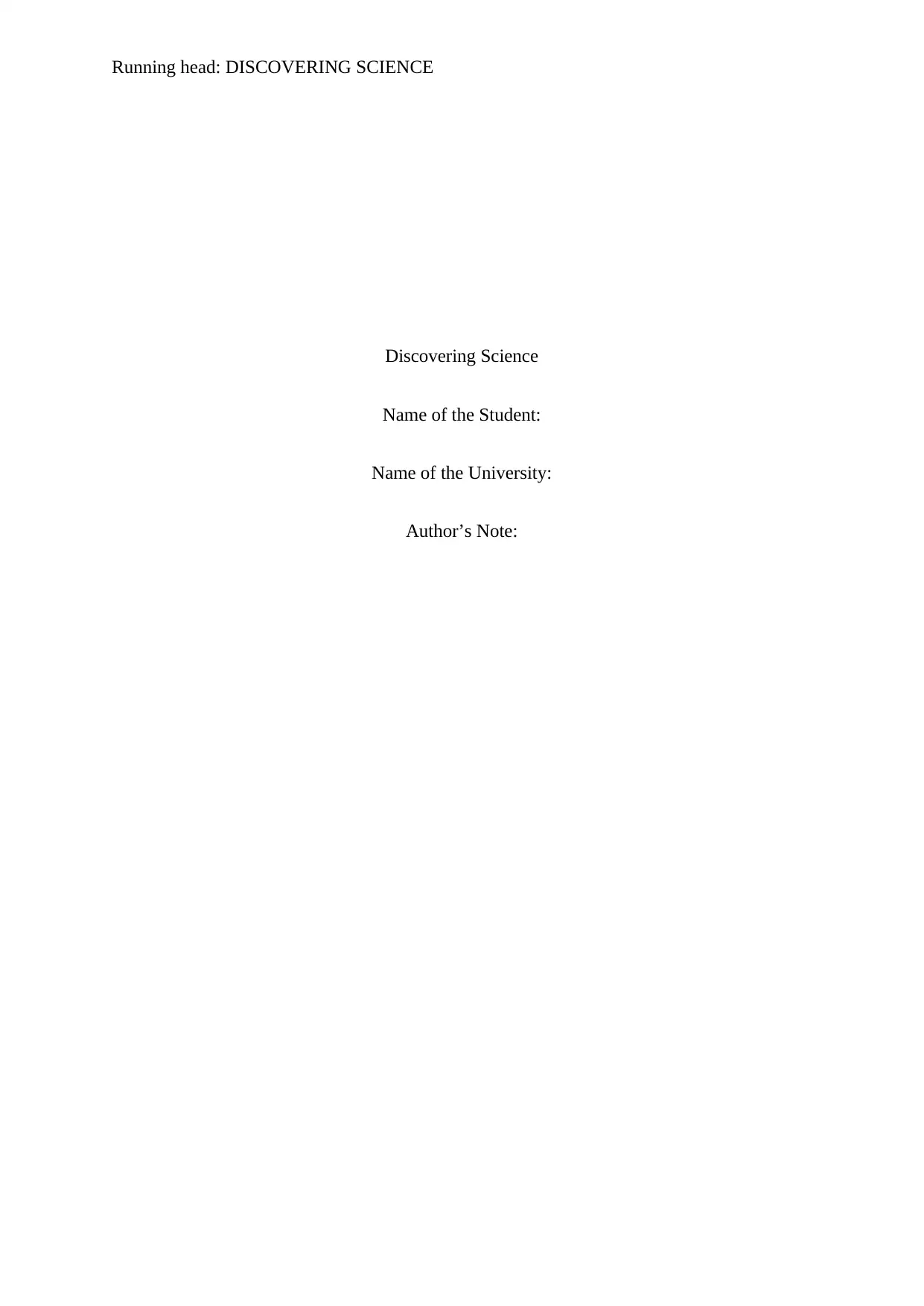
Running head: DISCOVERING SCIENCE
Discovering Science
Name of the Student:
Name of the University:
Author’s Note:
Discovering Science
Name of the Student:
Name of the University:
Author’s Note:
Secure Best Marks with AI Grader
Need help grading? Try our AI Grader for instant feedback on your assignments.
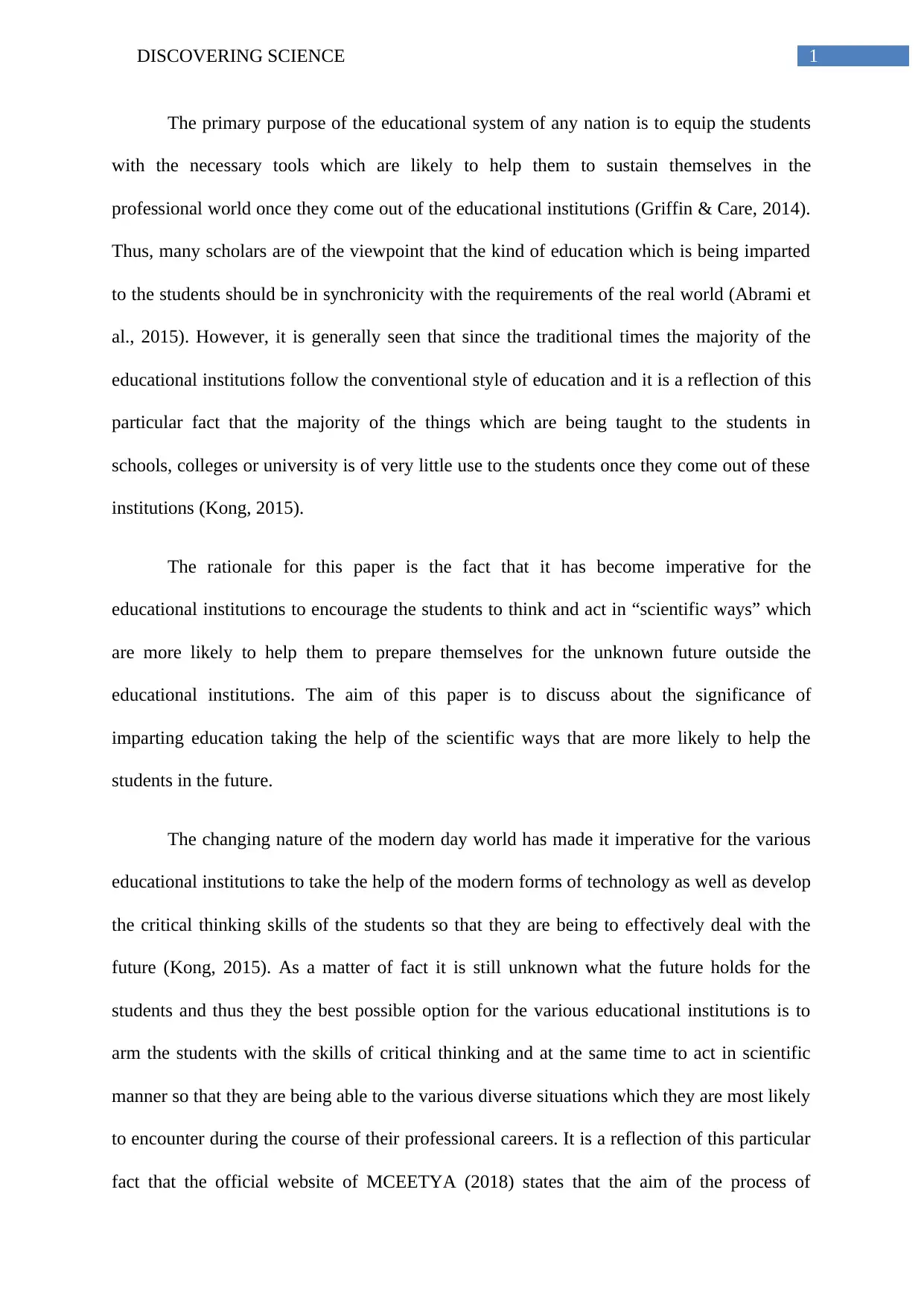
1DISCOVERING SCIENCE
The primary purpose of the educational system of any nation is to equip the students
with the necessary tools which are likely to help them to sustain themselves in the
professional world once they come out of the educational institutions (Griffin & Care, 2014).
Thus, many scholars are of the viewpoint that the kind of education which is being imparted
to the students should be in synchronicity with the requirements of the real world (Abrami et
al., 2015). However, it is generally seen that since the traditional times the majority of the
educational institutions follow the conventional style of education and it is a reflection of this
particular fact that the majority of the things which are being taught to the students in
schools, colleges or university is of very little use to the students once they come out of these
institutions (Kong, 2015).
The rationale for this paper is the fact that it has become imperative for the
educational institutions to encourage the students to think and act in “scientific ways” which
are more likely to help them to prepare themselves for the unknown future outside the
educational institutions. The aim of this paper is to discuss about the significance of
imparting education taking the help of the scientific ways that are more likely to help the
students in the future.
The changing nature of the modern day world has made it imperative for the various
educational institutions to take the help of the modern forms of technology as well as develop
the critical thinking skills of the students so that they are being to effectively deal with the
future (Kong, 2015). As a matter of fact it is still unknown what the future holds for the
students and thus they the best possible option for the various educational institutions is to
arm the students with the skills of critical thinking and at the same time to act in scientific
manner so that they are being able to the various diverse situations which they are most likely
to encounter during the course of their professional careers. It is a reflection of this particular
fact that the official website of MCEETYA (2018) states that the aim of the process of
The primary purpose of the educational system of any nation is to equip the students
with the necessary tools which are likely to help them to sustain themselves in the
professional world once they come out of the educational institutions (Griffin & Care, 2014).
Thus, many scholars are of the viewpoint that the kind of education which is being imparted
to the students should be in synchronicity with the requirements of the real world (Abrami et
al., 2015). However, it is generally seen that since the traditional times the majority of the
educational institutions follow the conventional style of education and it is a reflection of this
particular fact that the majority of the things which are being taught to the students in
schools, colleges or university is of very little use to the students once they come out of these
institutions (Kong, 2015).
The rationale for this paper is the fact that it has become imperative for the
educational institutions to encourage the students to think and act in “scientific ways” which
are more likely to help them to prepare themselves for the unknown future outside the
educational institutions. The aim of this paper is to discuss about the significance of
imparting education taking the help of the scientific ways that are more likely to help the
students in the future.
The changing nature of the modern day world has made it imperative for the various
educational institutions to take the help of the modern forms of technology as well as develop
the critical thinking skills of the students so that they are being to effectively deal with the
future (Kong, 2015). As a matter of fact it is still unknown what the future holds for the
students and thus they the best possible option for the various educational institutions is to
arm the students with the skills of critical thinking and at the same time to act in scientific
manner so that they are being able to the various diverse situations which they are most likely
to encounter during the course of their professional careers. It is a reflection of this particular
fact that the official website of MCEETYA (2018) states that the aim of the process of
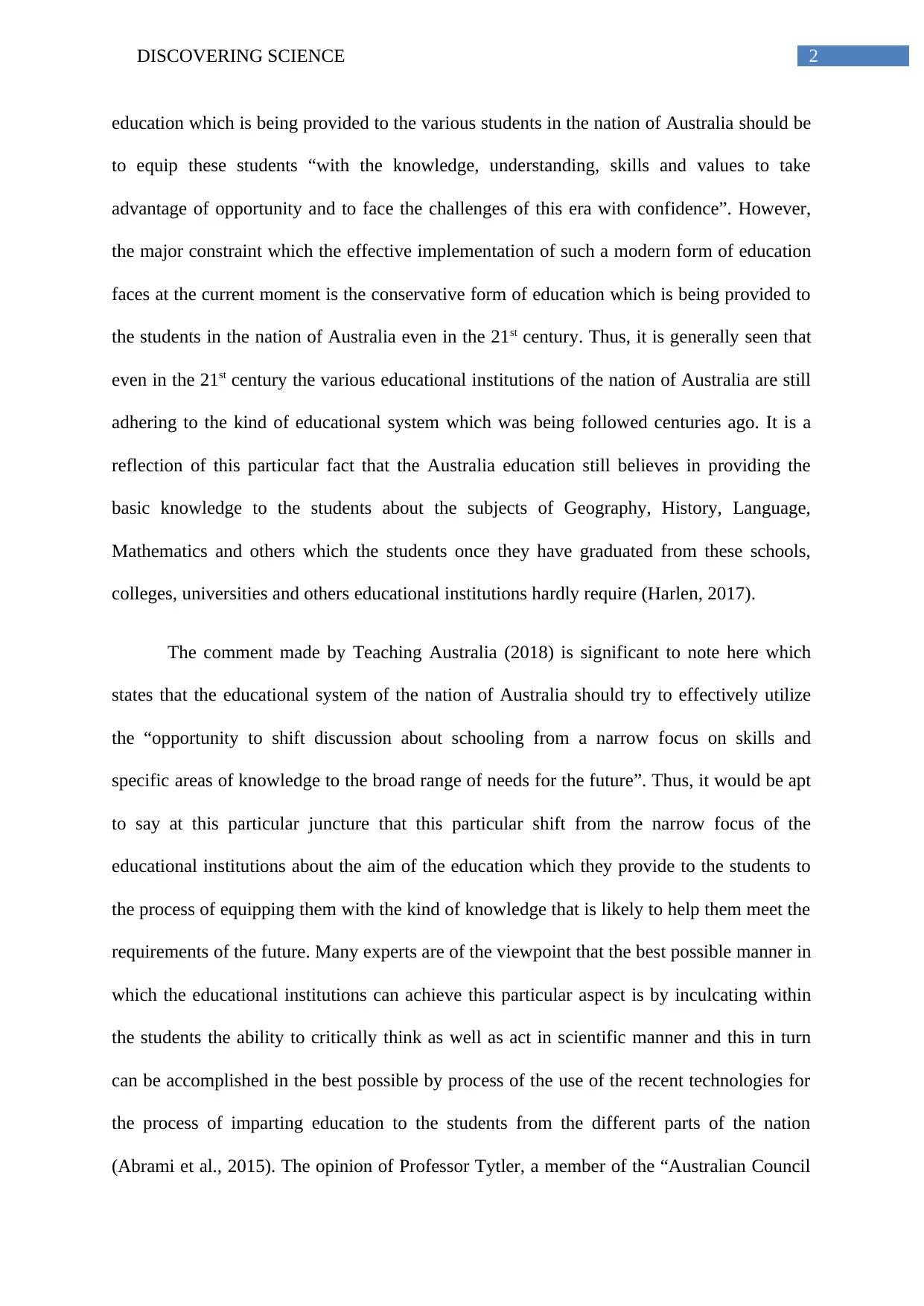
2DISCOVERING SCIENCE
education which is being provided to the various students in the nation of Australia should be
to equip these students “with the knowledge, understanding, skills and values to take
advantage of opportunity and to face the challenges of this era with confidence”. However,
the major constraint which the effective implementation of such a modern form of education
faces at the current moment is the conservative form of education which is being provided to
the students in the nation of Australia even in the 21st century. Thus, it is generally seen that
even in the 21st century the various educational institutions of the nation of Australia are still
adhering to the kind of educational system which was being followed centuries ago. It is a
reflection of this particular fact that the Australia education still believes in providing the
basic knowledge to the students about the subjects of Geography, History, Language,
Mathematics and others which the students once they have graduated from these schools,
colleges, universities and others educational institutions hardly require (Harlen, 2017).
The comment made by Teaching Australia (2018) is significant to note here which
states that the educational system of the nation of Australia should try to effectively utilize
the “opportunity to shift discussion about schooling from a narrow focus on skills and
specific areas of knowledge to the broad range of needs for the future”. Thus, it would be apt
to say at this particular juncture that this particular shift from the narrow focus of the
educational institutions about the aim of the education which they provide to the students to
the process of equipping them with the kind of knowledge that is likely to help them meet the
requirements of the future. Many experts are of the viewpoint that the best possible manner in
which the educational institutions can achieve this particular aspect is by inculcating within
the students the ability to critically think as well as act in scientific manner and this in turn
can be accomplished in the best possible by process of the use of the recent technologies for
the process of imparting education to the students from the different parts of the nation
(Abrami et al., 2015). The opinion of Professor Tytler, a member of the “Australian Council
education which is being provided to the various students in the nation of Australia should be
to equip these students “with the knowledge, understanding, skills and values to take
advantage of opportunity and to face the challenges of this era with confidence”. However,
the major constraint which the effective implementation of such a modern form of education
faces at the current moment is the conservative form of education which is being provided to
the students in the nation of Australia even in the 21st century. Thus, it is generally seen that
even in the 21st century the various educational institutions of the nation of Australia are still
adhering to the kind of educational system which was being followed centuries ago. It is a
reflection of this particular fact that the Australia education still believes in providing the
basic knowledge to the students about the subjects of Geography, History, Language,
Mathematics and others which the students once they have graduated from these schools,
colleges, universities and others educational institutions hardly require (Harlen, 2017).
The comment made by Teaching Australia (2018) is significant to note here which
states that the educational system of the nation of Australia should try to effectively utilize
the “opportunity to shift discussion about schooling from a narrow focus on skills and
specific areas of knowledge to the broad range of needs for the future”. Thus, it would be apt
to say at this particular juncture that this particular shift from the narrow focus of the
educational institutions about the aim of the education which they provide to the students to
the process of equipping them with the kind of knowledge that is likely to help them meet the
requirements of the future. Many experts are of the viewpoint that the best possible manner in
which the educational institutions can achieve this particular aspect is by inculcating within
the students the ability to critically think as well as act in scientific manner and this in turn
can be accomplished in the best possible by process of the use of the recent technologies for
the process of imparting education to the students from the different parts of the nation
(Abrami et al., 2015). The opinion of Professor Tytler, a member of the “Australian Council
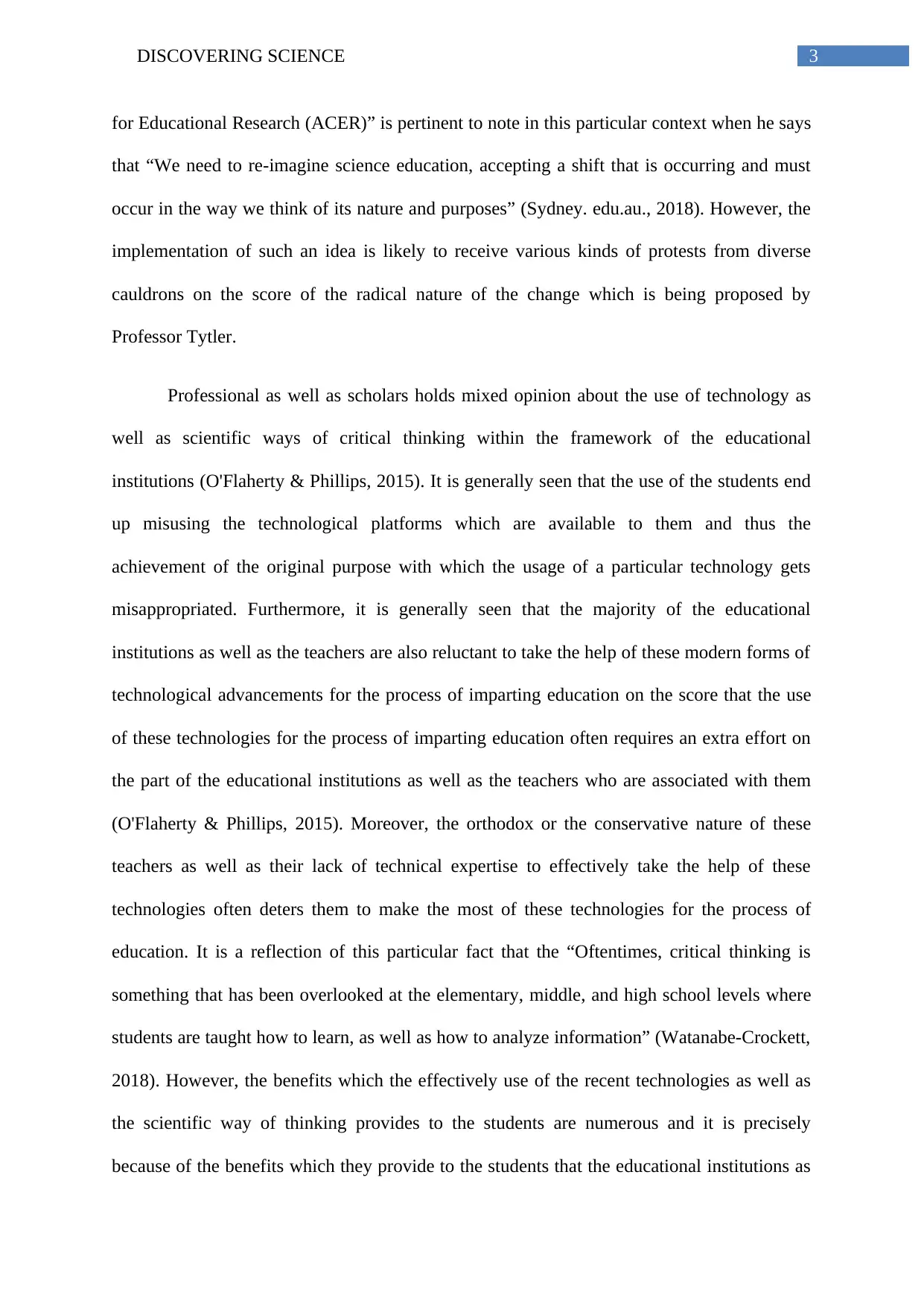
3DISCOVERING SCIENCE
for Educational Research (ACER)” is pertinent to note in this particular context when he says
that “We need to re-imagine science education, accepting a shift that is occurring and must
occur in the way we think of its nature and purposes” (Sydney. edu.au., 2018). However, the
implementation of such an idea is likely to receive various kinds of protests from diverse
cauldrons on the score of the radical nature of the change which is being proposed by
Professor Tytler.
Professional as well as scholars holds mixed opinion about the use of technology as
well as scientific ways of critical thinking within the framework of the educational
institutions (O'Flaherty & Phillips, 2015). It is generally seen that the use of the students end
up misusing the technological platforms which are available to them and thus the
achievement of the original purpose with which the usage of a particular technology gets
misappropriated. Furthermore, it is generally seen that the majority of the educational
institutions as well as the teachers are also reluctant to take the help of these modern forms of
technological advancements for the process of imparting education on the score that the use
of these technologies for the process of imparting education often requires an extra effort on
the part of the educational institutions as well as the teachers who are associated with them
(O'Flaherty & Phillips, 2015). Moreover, the orthodox or the conservative nature of these
teachers as well as their lack of technical expertise to effectively take the help of these
technologies often deters them to make the most of these technologies for the process of
education. It is a reflection of this particular fact that the “Oftentimes, critical thinking is
something that has been overlooked at the elementary, middle, and high school levels where
students are taught how to learn, as well as how to analyze information” (Watanabe-Crockett,
2018). However, the benefits which the effectively use of the recent technologies as well as
the scientific way of thinking provides to the students are numerous and it is precisely
because of the benefits which they provide to the students that the educational institutions as
for Educational Research (ACER)” is pertinent to note in this particular context when he says
that “We need to re-imagine science education, accepting a shift that is occurring and must
occur in the way we think of its nature and purposes” (Sydney. edu.au., 2018). However, the
implementation of such an idea is likely to receive various kinds of protests from diverse
cauldrons on the score of the radical nature of the change which is being proposed by
Professor Tytler.
Professional as well as scholars holds mixed opinion about the use of technology as
well as scientific ways of critical thinking within the framework of the educational
institutions (O'Flaherty & Phillips, 2015). It is generally seen that the use of the students end
up misusing the technological platforms which are available to them and thus the
achievement of the original purpose with which the usage of a particular technology gets
misappropriated. Furthermore, it is generally seen that the majority of the educational
institutions as well as the teachers are also reluctant to take the help of these modern forms of
technological advancements for the process of imparting education on the score that the use
of these technologies for the process of imparting education often requires an extra effort on
the part of the educational institutions as well as the teachers who are associated with them
(O'Flaherty & Phillips, 2015). Moreover, the orthodox or the conservative nature of these
teachers as well as their lack of technical expertise to effectively take the help of these
technologies often deters them to make the most of these technologies for the process of
education. It is a reflection of this particular fact that the “Oftentimes, critical thinking is
something that has been overlooked at the elementary, middle, and high school levels where
students are taught how to learn, as well as how to analyze information” (Watanabe-Crockett,
2018). However, the benefits which the effectively use of the recent technologies as well as
the scientific way of thinking provides to the students are numerous and it is precisely
because of the benefits which they provide to the students that the educational institutions as
Secure Best Marks with AI Grader
Need help grading? Try our AI Grader for instant feedback on your assignments.
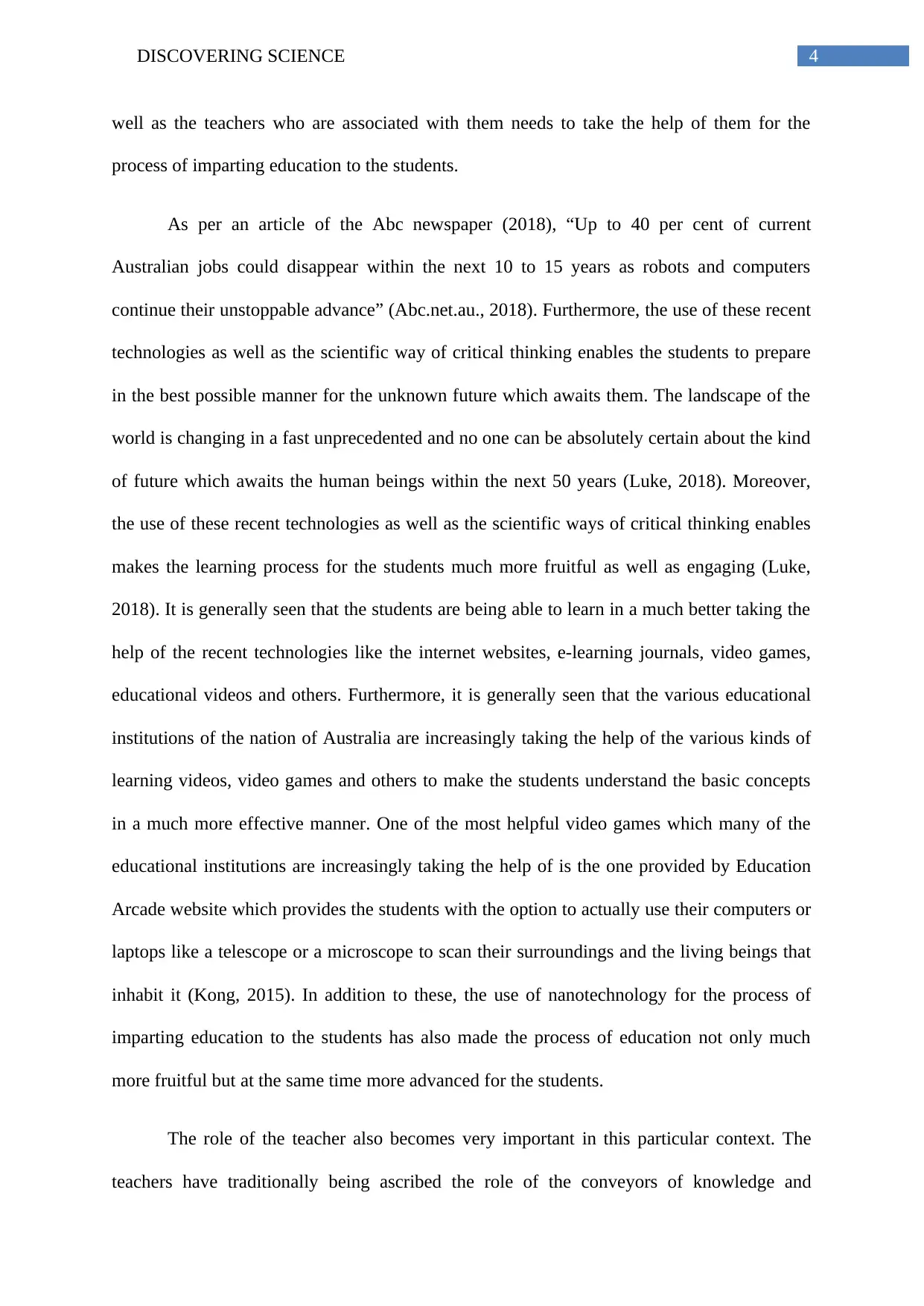
4DISCOVERING SCIENCE
well as the teachers who are associated with them needs to take the help of them for the
process of imparting education to the students.
As per an article of the Abc newspaper (2018), “Up to 40 per cent of current
Australian jobs could disappear within the next 10 to 15 years as robots and computers
continue their unstoppable advance” (Abc.net.au., 2018). Furthermore, the use of these recent
technologies as well as the scientific way of critical thinking enables the students to prepare
in the best possible manner for the unknown future which awaits them. The landscape of the
world is changing in a fast unprecedented and no one can be absolutely certain about the kind
of future which awaits the human beings within the next 50 years (Luke, 2018). Moreover,
the use of these recent technologies as well as the scientific ways of critical thinking enables
makes the learning process for the students much more fruitful as well as engaging (Luke,
2018). It is generally seen that the students are being able to learn in a much better taking the
help of the recent technologies like the internet websites, e-learning journals, video games,
educational videos and others. Furthermore, it is generally seen that the various educational
institutions of the nation of Australia are increasingly taking the help of the various kinds of
learning videos, video games and others to make the students understand the basic concepts
in a much more effective manner. One of the most helpful video games which many of the
educational institutions are increasingly taking the help of is the one provided by Education
Arcade website which provides the students with the option to actually use their computers or
laptops like a telescope or a microscope to scan their surroundings and the living beings that
inhabit it (Kong, 2015). In addition to these, the use of nanotechnology for the process of
imparting education to the students has also made the process of education not only much
more fruitful but at the same time more advanced for the students.
The role of the teacher also becomes very important in this particular context. The
teachers have traditionally being ascribed the role of the conveyors of knowledge and
well as the teachers who are associated with them needs to take the help of them for the
process of imparting education to the students.
As per an article of the Abc newspaper (2018), “Up to 40 per cent of current
Australian jobs could disappear within the next 10 to 15 years as robots and computers
continue their unstoppable advance” (Abc.net.au., 2018). Furthermore, the use of these recent
technologies as well as the scientific way of critical thinking enables the students to prepare
in the best possible manner for the unknown future which awaits them. The landscape of the
world is changing in a fast unprecedented and no one can be absolutely certain about the kind
of future which awaits the human beings within the next 50 years (Luke, 2018). Moreover,
the use of these recent technologies as well as the scientific ways of critical thinking enables
makes the learning process for the students much more fruitful as well as engaging (Luke,
2018). It is generally seen that the students are being able to learn in a much better taking the
help of the recent technologies like the internet websites, e-learning journals, video games,
educational videos and others. Furthermore, it is generally seen that the various educational
institutions of the nation of Australia are increasingly taking the help of the various kinds of
learning videos, video games and others to make the students understand the basic concepts
in a much more effective manner. One of the most helpful video games which many of the
educational institutions are increasingly taking the help of is the one provided by Education
Arcade website which provides the students with the option to actually use their computers or
laptops like a telescope or a microscope to scan their surroundings and the living beings that
inhabit it (Kong, 2015). In addition to these, the use of nanotechnology for the process of
imparting education to the students has also made the process of education not only much
more fruitful but at the same time more advanced for the students.
The role of the teacher also becomes very important in this particular context. The
teachers have traditionally being ascribed the role of the conveyors of knowledge and
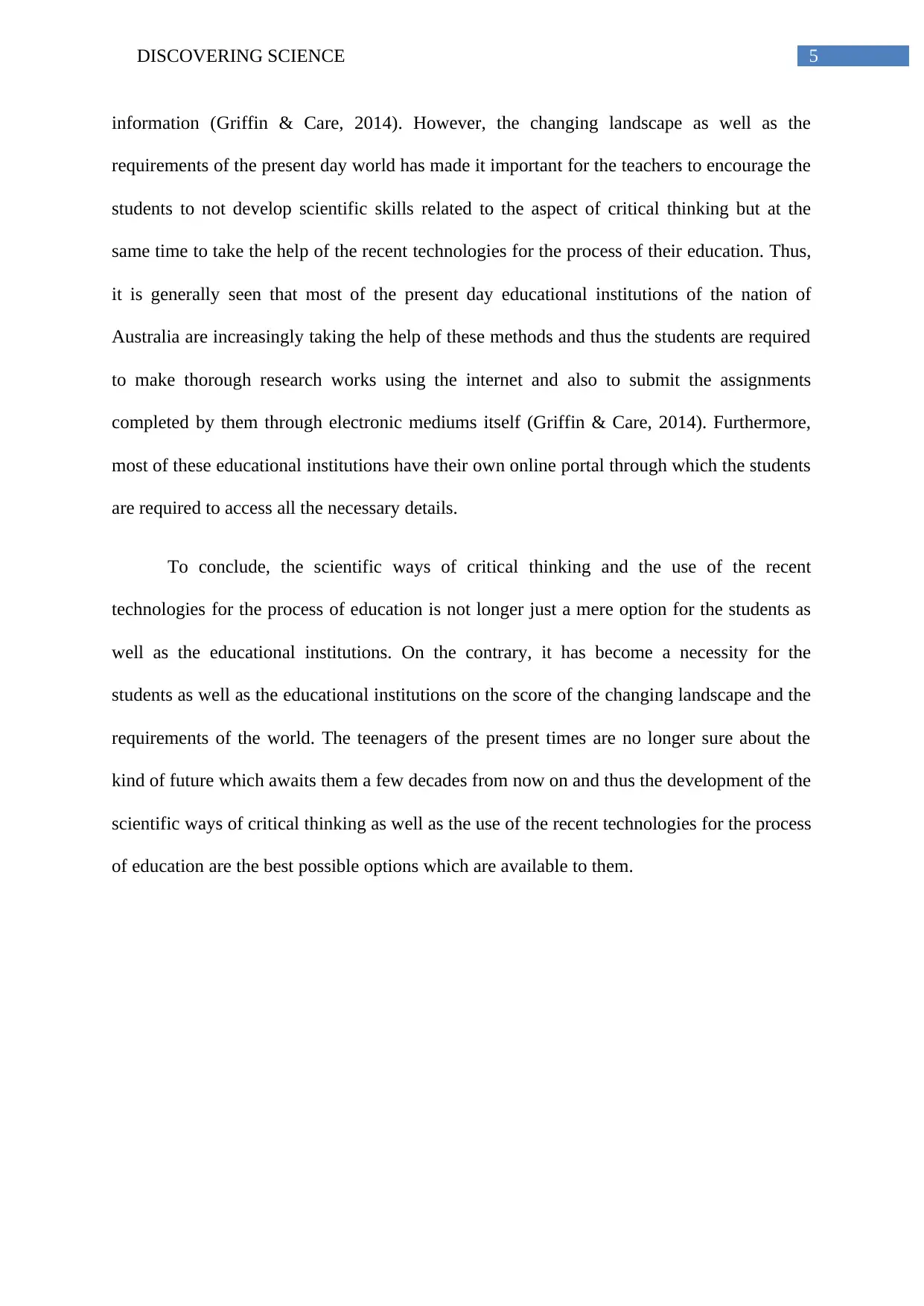
5DISCOVERING SCIENCE
information (Griffin & Care, 2014). However, the changing landscape as well as the
requirements of the present day world has made it important for the teachers to encourage the
students to not develop scientific skills related to the aspect of critical thinking but at the
same time to take the help of the recent technologies for the process of their education. Thus,
it is generally seen that most of the present day educational institutions of the nation of
Australia are increasingly taking the help of these methods and thus the students are required
to make thorough research works using the internet and also to submit the assignments
completed by them through electronic mediums itself (Griffin & Care, 2014). Furthermore,
most of these educational institutions have their own online portal through which the students
are required to access all the necessary details.
To conclude, the scientific ways of critical thinking and the use of the recent
technologies for the process of education is not longer just a mere option for the students as
well as the educational institutions. On the contrary, it has become a necessity for the
students as well as the educational institutions on the score of the changing landscape and the
requirements of the world. The teenagers of the present times are no longer sure about the
kind of future which awaits them a few decades from now on and thus the development of the
scientific ways of critical thinking as well as the use of the recent technologies for the process
of education are the best possible options which are available to them.
information (Griffin & Care, 2014). However, the changing landscape as well as the
requirements of the present day world has made it important for the teachers to encourage the
students to not develop scientific skills related to the aspect of critical thinking but at the
same time to take the help of the recent technologies for the process of their education. Thus,
it is generally seen that most of the present day educational institutions of the nation of
Australia are increasingly taking the help of these methods and thus the students are required
to make thorough research works using the internet and also to submit the assignments
completed by them through electronic mediums itself (Griffin & Care, 2014). Furthermore,
most of these educational institutions have their own online portal through which the students
are required to access all the necessary details.
To conclude, the scientific ways of critical thinking and the use of the recent
technologies for the process of education is not longer just a mere option for the students as
well as the educational institutions. On the contrary, it has become a necessity for the
students as well as the educational institutions on the score of the changing landscape and the
requirements of the world. The teenagers of the present times are no longer sure about the
kind of future which awaits them a few decades from now on and thus the development of the
scientific ways of critical thinking as well as the use of the recent technologies for the process
of education are the best possible options which are available to them.
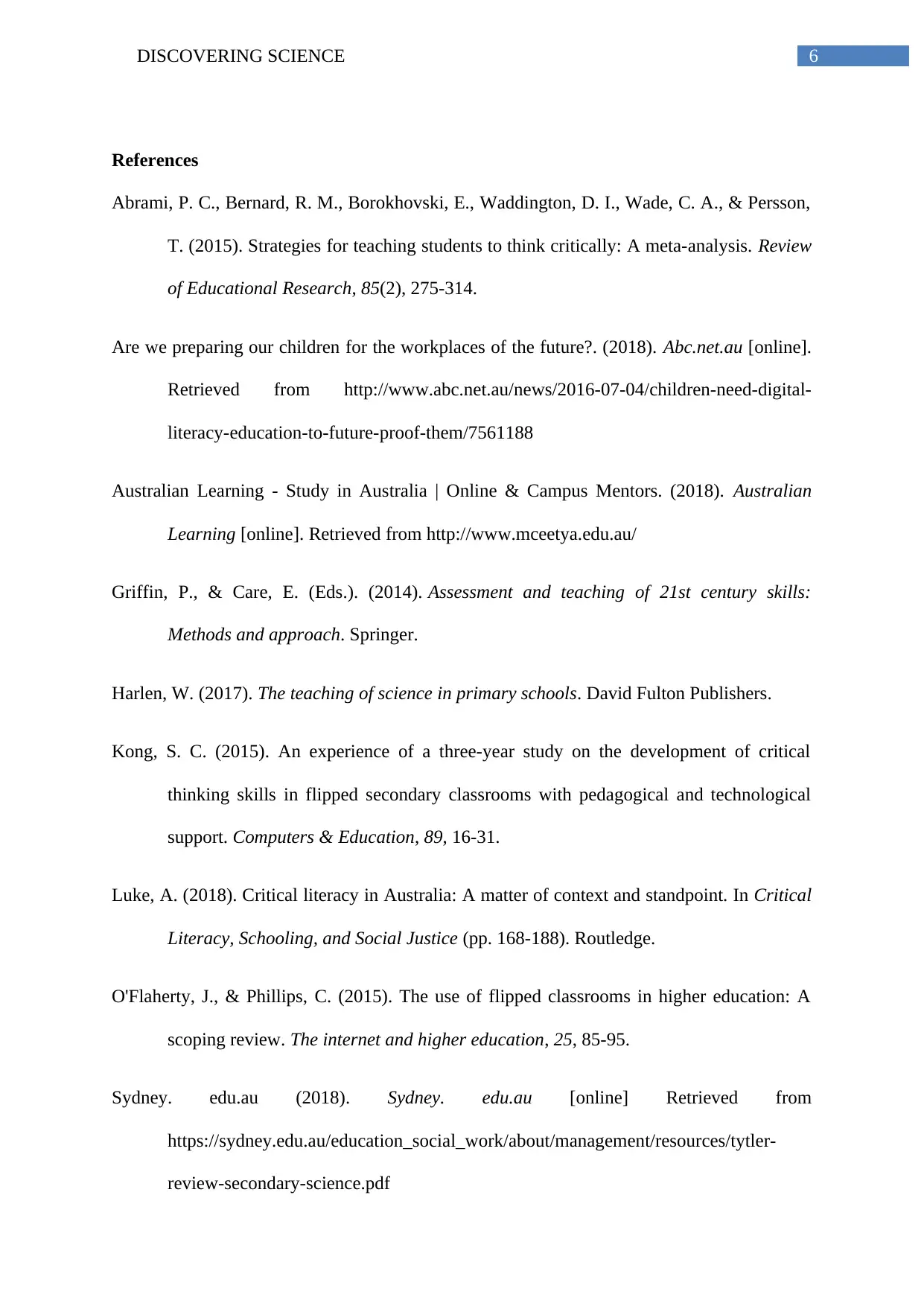
6DISCOVERING SCIENCE
References
Abrami, P. C., Bernard, R. M., Borokhovski, E., Waddington, D. I., Wade, C. A., & Persson,
T. (2015). Strategies for teaching students to think critically: A meta-analysis. Review
of Educational Research, 85(2), 275-314.
Are we preparing our children for the workplaces of the future?. (2018). Abc.net.au [online].
Retrieved from http://www.abc.net.au/news/2016-07-04/children-need-digital-
literacy-education-to-future-proof-them/7561188
Australian Learning - Study in Australia | Online & Campus Mentors. (2018). Australian
Learning [online]. Retrieved from http://www.mceetya.edu.au/
Griffin, P., & Care, E. (Eds.). (2014). Assessment and teaching of 21st century skills:
Methods and approach. Springer.
Harlen, W. (2017). The teaching of science in primary schools. David Fulton Publishers.
Kong, S. C. (2015). An experience of a three-year study on the development of critical
thinking skills in flipped secondary classrooms with pedagogical and technological
support. Computers & Education, 89, 16-31.
Luke, A. (2018). Critical literacy in Australia: A matter of context and standpoint. In Critical
Literacy, Schooling, and Social Justice (pp. 168-188). Routledge.
O'Flaherty, J., & Phillips, C. (2015). The use of flipped classrooms in higher education: A
scoping review. The internet and higher education, 25, 85-95.
Sydney. edu.au (2018). Sydney. edu.au [online] Retrieved from
https://sydney.edu.au/education_social_work/about/management/resources/tytler-
review-secondary-science.pdf
References
Abrami, P. C., Bernard, R. M., Borokhovski, E., Waddington, D. I., Wade, C. A., & Persson,
T. (2015). Strategies for teaching students to think critically: A meta-analysis. Review
of Educational Research, 85(2), 275-314.
Are we preparing our children for the workplaces of the future?. (2018). Abc.net.au [online].
Retrieved from http://www.abc.net.au/news/2016-07-04/children-need-digital-
literacy-education-to-future-proof-them/7561188
Australian Learning - Study in Australia | Online & Campus Mentors. (2018). Australian
Learning [online]. Retrieved from http://www.mceetya.edu.au/
Griffin, P., & Care, E. (Eds.). (2014). Assessment and teaching of 21st century skills:
Methods and approach. Springer.
Harlen, W. (2017). The teaching of science in primary schools. David Fulton Publishers.
Kong, S. C. (2015). An experience of a three-year study on the development of critical
thinking skills in flipped secondary classrooms with pedagogical and technological
support. Computers & Education, 89, 16-31.
Luke, A. (2018). Critical literacy in Australia: A matter of context and standpoint. In Critical
Literacy, Schooling, and Social Justice (pp. 168-188). Routledge.
O'Flaherty, J., & Phillips, C. (2015). The use of flipped classrooms in higher education: A
scoping review. The internet and higher education, 25, 85-95.
Sydney. edu.au (2018). Sydney. edu.au [online] Retrieved from
https://sydney.edu.au/education_social_work/about/management/resources/tytler-
review-secondary-science.pdf
Paraphrase This Document
Need a fresh take? Get an instant paraphrase of this document with our AI Paraphraser
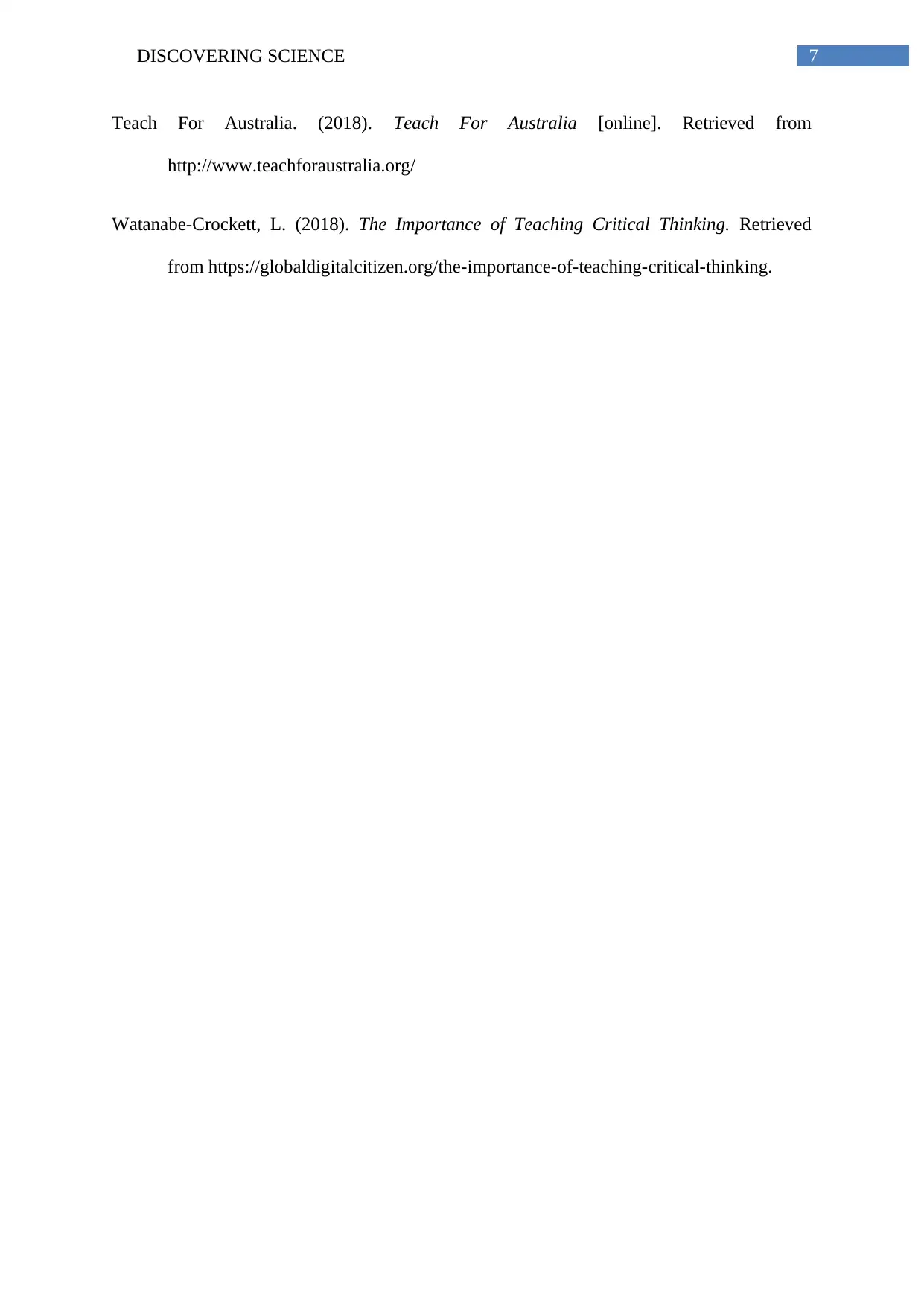
7DISCOVERING SCIENCE
Teach For Australia. (2018). Teach For Australia [online]. Retrieved from
http://www.teachforaustralia.org/
Watanabe-Crockett, L. (2018). The Importance of Teaching Critical Thinking. Retrieved
from https://globaldigitalcitizen.org/the-importance-of-teaching-critical-thinking.
Teach For Australia. (2018). Teach For Australia [online]. Retrieved from
http://www.teachforaustralia.org/
Watanabe-Crockett, L. (2018). The Importance of Teaching Critical Thinking. Retrieved
from https://globaldigitalcitizen.org/the-importance-of-teaching-critical-thinking.
1 out of 8
Related Documents
Your All-in-One AI-Powered Toolkit for Academic Success.
+13062052269
info@desklib.com
Available 24*7 on WhatsApp / Email
![[object Object]](/_next/static/media/star-bottom.7253800d.svg)
Unlock your academic potential
© 2024 | Zucol Services PVT LTD | All rights reserved.





